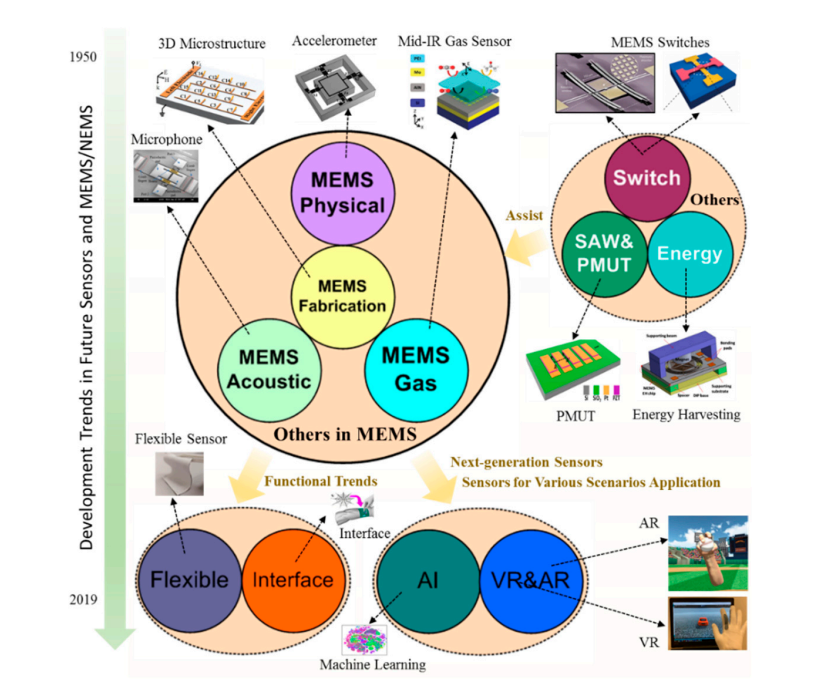
Video Upload Options
Al increases the potential of Micro-Electro-Mechanical System biosensors and opens up new opportunities for automation, consumer electronics, industrial manufacturing, defense, medical equipment, etc. Micro-Electro-Mechanical System microcantilever biosensors are currently making their way into the daily lives and playing a significant role in the advancement of social technology. Micro-Electro-Mechanical System biosensors with microcantilever structures have a num- ber of benefits over conventional biosensors, including small size, high sensitivity, mass production, simple arraying, integration, etc. These advantages have made them one of the development avenues for high-sensitivity sensors. The next generation of sensors will exhibit an intelligent development trajectory and aid people in interacting with other objects in a variety of scenario applications as a result of the active development of artificial intelligence (AI) and neural networks. A neural algorithm application in Micro-Electro-Mechanical System microcantilever biosensors is anticipated through the associated application of the principal com-ponent analysis approach. Researchers investigation has more scientific study value, because there are currently no favorable reports on the market regarding the use of AI with Micro-Electro-Mechanical System microcantilever sensors.
1. Introduction
Sensor technology is evolving as a result of advances in science technology and the popularization of information technology. Sensor development has gone through three generations thus far. Structural sensors make up the initial generation of sensors. By utilizing the pertinent sensor system variables, this kind of sensor can convert the signal and detect changes in the signal. A solid-state sensor is the second kind of sensor and is made of semiconductors, electrolytes, and magnetic components. In the 1970s, this kind of sensor started to evolve. This generation of sensors, which currently account for about 75% of the sensor industry, are often characterized by low cost, high accuracy, and outstanding performance. The smart sensor that this research primarily introduces is the third-generation sensor. Miniaturization and intelligence are currently the two major requirements for sensor systems due to the growth of the Internet and the improvement in human demands. Microelectromechanical systems (MEMS) are integrated at the nanoscale and microscale. As a result, MEMS sensors differ from conventional sensors in that they are miniaturized, integrated with microelectronics, and manufactured in parallel with great precision. The potential use of MEMS and nanotechnology in the sensing sector is typically thought of due to their lower size, simpler integration into systems, better portability, and mobility.

2. Research State of AI Applications in Biosensors
Artificial intelligence has advanced quickly and is currently a popular field of study in technology. It uses densely connected networks to process information in a manner that mimics how the human brain processes information. It is capable of self-learning, parallel processing, and powerful information storage. The fields of application for artificial intelligence are growing as the field’s theory and technology mature. People are already able to see how artificial intelligence and MEMS sensors work together.Include Gas Sensing Fiel, Sound Detection Field, Body Sensor Field and Wearable Sensing Field etc.
3. Research Status of MEMS Microcantilever Biosensors
Micro-Electro-Mechanical Systems, sometimes known as MEMS, are electronic mechanical systems. It is a microelectromechanical system that incorporates interface circuits, signal processing and control circuits, microsensors, and microactuators. The microcantilever biosensor operates on the theory that, when the material being tested adheres to or remains on its surface, the mass of the microcantilever changes, which causes the microresonant cantilever’s frequency to change. The quality of the test object can be determined by measuring the size of the frequency offset.
The benefits of the miniaturization, integration, intelligence, low cost, and mass production of MEMS microcantilever biosensors have made them popular in a variety of industries, including wireless communication 32, biomedicine 33, military defense 34, consumer electronics 35, and many more. It may be claimed that MEMS microcantilever biosensors, to a certain extent, represent the future development of sensor technology, because these advantages are consistent with the path of future sensor development.
4. The Application Prospect of Neural Network in MEMS Microcantilever Biosensor
A type of sensor with significant current development potential is the MEMS micro- cantilever biosensor. Due to its benefits in miniaturization, integration, intelligence, low cost, and mass production, it has been extensively employed in wireless communication, biomedicine, military defense, consumer electronics, and other disciplines. It is now pos- sible to use high tech in microcantilever biosensors and spur their development in the present world, where computer science and technology are advancing one after the other.
Neural networks have advanced significantly in models, learning techniques, and ap plications in recent years. Due to its traits of self-adaptation, generalization, nonlin- ear mapping, and extremely parallel processing, it has been widely used in the field of smart sensors. The application increases the sensor’s intelligence and raises its level of intelligence.
5. Application of Principal Component Analysis in Biosensors
The principal component analysis (PCA) has been employed for a long time as a fault neural network. It uses a vast network of extensive connections of a significant number of detection technique to extract pertinent data from multivariate sensors. The PCA has been neurons for information processing and simulates the information processing function of used to analyze multivariate data for a number of multivariate data analysis technolo-the human brain. It offers powerful parallel processing, information storage, and self-gies, including sensor process monitoring, quality control, and problem diagnosis.
6. Conclusions
Future sensors and microelectromechanical systems (MEMS) will play an increasingly significant part in the daily lives as people enter the new era of intelligence and experience the rapid growth of technology. As a result, MEMS sensor systems integrate neural networks and artificial intelligence (AI), and the following iteration of sensors will have a distinct development trajectory. This essay explores the possibility of fusing MEMS microcantilever biosensors with neural algorithms, as well as the specific case of fusing AI with MEMS biosensors. As a sensor type with several benefits, including portability, affordability, and high sensitivity, its integration with the Internet should go beyond the use of neural networks and instead help people interact with other objects in a variety of scenario applications.




